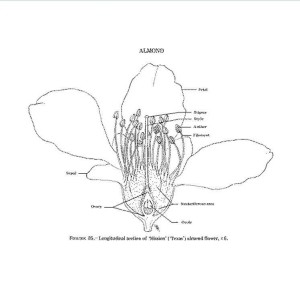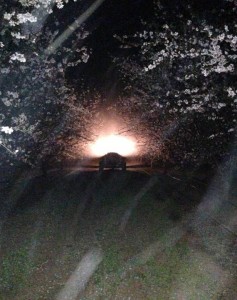Almond bloom has begun. No time of the season is more important to delivering a good crop. You don’t get a Mulligan at almond bloom. Good pollinization, delivery of viable pollen grains to the flower stigma of a compatible flower, is the first step of a successful bloom season. Keeping spray materials off the pollen helps keep the pollen viable for germination (the next step in a good crop) and healthy for bees—the key pollinators from Red Bluff to Bakersfield.

Bee hives should be placed in locations where early morning sun can warm the hives so bees can be active earlier in the day. Hives should be dispersed through large blocks (larger than 40 acres) at distances no greater than a quarter mile. If the blocks are smaller than 40 acres, bees can be placed around the perimeter of the block. Clean water sources, replaced after fungicide sprays, should be available. A five gallon bucket with a burlap bag draped over the lip of the bucket – to allow bees to walk to the water and drink without drowning – is a good water station for bees. Don’t spray hives directly when applying fungicides.
Dilute liquid such as rain water or fungicide spray solution can harm pollen grains and/or germination. Keeping spray off pollen grains helps keep more viable pollen in the orchard. Click HERE to see article on fungicides and pollen germination by Dr. Eric Mussen, UC Extension specialist.
Some fungicides can harm bee hive health. Click HERE to see the summary of an article by Dr. Mussen on fungicides and bee health. Fungicides enter a hive on fungicide-sprayed pollen collected by foragers.
Fungicides protect flowers from disease infection, including blossom brown rot,

anthracnose, green fruit rot and shot hole. Infected flowers can produce wood infections that increase disease pressure in the orchard in future years, harming the orchard performance in the current and future years. In wet, rainy bloom weather, UC recommends two bloom sprays, one at pink bud and one at full bloom. In a dry bloom period, where no rain falls, but dew can wet flowers, a single spray is recommended between 50-100% full bloom.
What about “tank mix partners” at bloom? Some insecticides (for peach twig borer control), nutrients, and/or adjuvants can legally be added to bloom sprays. At present, the impact of all these materials and/or possible combinations on bee and hive health has not been extensively studied. There are other, equally effective timings for peach twig borer control and/or foliar nutrient sprays. The only reason to be spraying almond flowers is to prevent disease infection. Until we learn more about bees and sprays, the only thing in the tank at almond bloom should be fungicide(s).
How do you protect flowers while minimizing the chance of harming pollen or bees? Spray when the pollen is gone for the day –in the late afternoon, evening and night. Almond flowers don’t release all their pollen at once. On a daily basis, after the flower opens, some of the many anthers on a flower (see picture below) release their pollen when the relative humidity drops in the orchard. The pollen released in a day is often completely removed by foraging bees by the early to mid-afternoon in orchards with good bee activity. More pollen is released the next day, but that leaves a window between late afternoon and early morning for fungicides to be sprayed without touching pollen.
The best single site for comprehensive, current information on tree nut disease control is the UC publication on fungicide, bactericides, and biologicials for deciduous tree crops. Click HERE to see that free publication in pdf format. It is updated every year and contains research-based information on fungicide timing, efficacy, and resistance management rotations for almonds on pages 25-28 of the 2013 edition, the most recent.
A good fungicide stewardship program is key to a sustainable disease management program – one that works now and in the long run. Dr. Jim Adaskaveg, UC Riverside, has developed guidelines (R.U.L.E.S.) for growers and PCAs to manage diseases as effectively as possible: Rotate chemistries, Use labeled rates, Limit the use of any single site fungicide to once or twice per season, Educate yourself on fungicides, how they work (modes of action) and on what diseases, and Start a fungicide program with a robust, low resistance risk spray – low resistance risk material or tank mix/jug mix of fungicides. Don’t play chicken with fungicide resistance in your orchards. Follow the R.U.L.E.S.
Bloom is the most important time of the year in almond orchards. Successful pollen transfer (pollinization) is vital to setting a crop. Protecting flowers from disease is also important. Take care of the bees and the flowers to ensure the best possible results.


Sam
February 9, 2014How much less coverage do you get when using a helicopter vs ground rig for bloom sprays? Would using a helicopter for bloom sprays affect your choice of materials? Thank you
David Doll
February 10, 2014Hi Sam:
I haven’t done any comparison of ground vs helicopters, but during bloom there is a better chance of good coverage with a chopper than at any other time as leaf-out hasn’t started (much). Orchard access will be limited following the rain this weekend in the north state, so a helicopter spray will have to work. I know a lot of growers who use helicopters on almond, especially early in the season, with very good results. Once the leaves come out, ground rigs generally do a better job than aerial application.
Sincerely,
Franz
2014 Top Ten Articles - The Almond Doctor
December 30, 2014[…] Pollen, Bees, R.U.L.E.S. and Almond Bloom. A great article by Franz that discusses bloom time spray considerations when applying pesticides […]